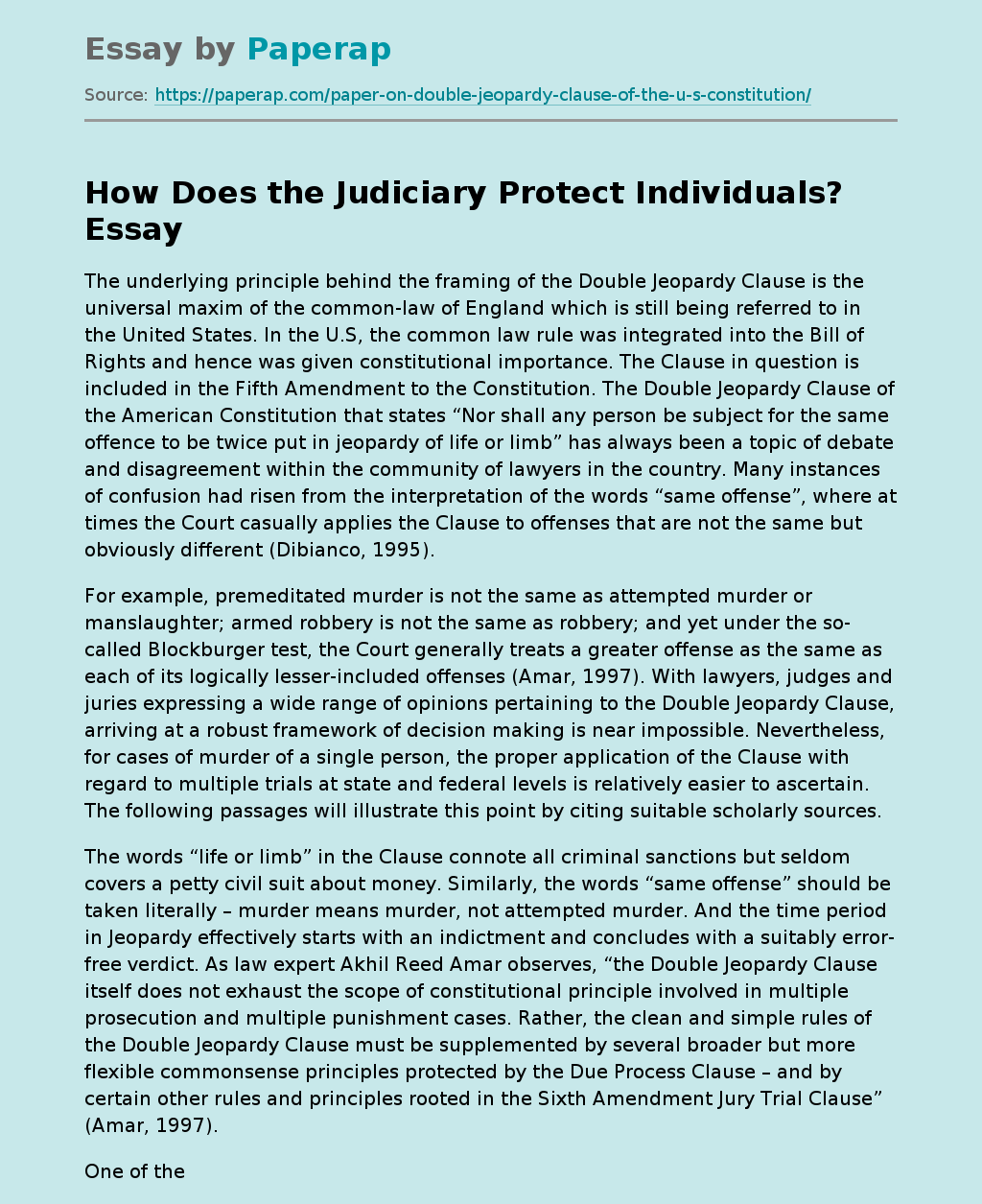How Does the Judiciary Protect Individuals?
The underlying principle behind the framing of the Double Jeopardy Clause is the universal maxim of the common-law of England which is still being referred to in the United States. In the U.S, the common law rule was integrated into the Bill of Rights and hence was given constitutional importance. The Clause in question is included in the Fifth Amendment to the Constitution. The Double Jeopardy Clause of the American Constitution that states “Nor shall any person be subject for the same offence to be twice put in jeopardy of life or limb” has always been a topic of debate and disagreement within the community of lawyers in the country.
Many instances of confusion had risen from the interpretation of the words “same offense”, where at times the Court casually applies the Clause to offenses that are not the same but obviously different (Dibianco, 1995).
For example, premeditated murder is not the same as attempted murder or manslaughter; armed robbery is not the same as robbery; and yet under the so-called Blockburger test, the Court generally treats a greater offense as the same as each of its logically lesser-included offenses (Amar, 1997).
With lawyers, judges and juries expressing a wide range of opinions pertaining to the Double Jeopardy Clause, arriving at a robust framework of decision making is near impossible. Nevertheless, for cases of murder of a single person, the proper application of the Clause with regard to multiple trials at state and federal levels is relatively easier to ascertain. The following passages will illustrate this point by citing suitable scholarly sources.
The words “life or limb” in the Clause connote all criminal sanctions but seldom covers a petty civil suit about money. Similarly, the words “same offense” should be taken literally – murder means murder, not attempted murder. And the time period in Jeopardy effectively starts with an indictment and concludes with a suitably error-free verdict. As law expert Akhil Reed Amar observes, “the Double Jeopardy Clause itself does not exhaust the scope of constitutional principle involved in multiple prosecution and multiple punishment cases. Rather, the clean and simple rules of the Double Jeopardy Clause must be supplemented by several broader but more flexible commonsense principles protected by the Due Process Clause – and by certain other rules and principles rooted in the Sixth Amendment Jury Trial Clause” (Amar, 1997).
One of the mechanisms through which the judiciary ensures to provide the individual under trial protection from Double Jeopardy is through the perusal of Sentencing Guidelines. For example, even if a person is tried in court at two different state-level courts or a state and a federal court for an alleged murder, proper application of the guidelines will ensure that subsequent conviction of ‘relevant conduct’ does not result in double punishment for the same crimes under the Double Jeopardy Clause (Rudstein, 2004).
Moreover, the Blockburger test proposed by the Supreme Court in 1932, in the Blockburger v. United States case, sets forth a robust test to ascertain whether the Double Jeopardy Clause is violated or not in situations where a defendant was subject to multiple trials and possibly multiple convictions. In addition, the clause gives protection to the defendant against both a succeeding prosecution for the same charge after acquittal or conviction and multiple punishments for the same charge. In effect, the Double Jeopardy Clause restrains courts and prosecutors, while leaving the legislature free to define crimes and fix punishments.
Once the legislature has defined crimes and fixed punishments, courts cannot impose more than one punishment for the same offense and, ordinarily, prosecutors cannot attempt to secure that punishment in more than one trial. Courts must assume, absent evidence to the contrary, that Congress did not intend to punish the same offense under two different statutes. (Elizabeth Wiet, 1996)
Forty years after the Blockburger case, the Supreme Court drafted an updated Double Jeopardy test. This test criterion first found application in the Ashe v. Swenson case. Justice Stewart reasoned at the time that “under the majority’s ‘same evidence’ test, when there is a general verdict of acquittal, a court must look at the prior proceedings and conclude whether the jury grounded its verdict upon an issue other than that which the defendant seeks to foreclose from consideration.
To this was added the ‘same transaction, same conduct and ‘same element tests in subsequent years to provide for various circumstances of application of the clause (Elizabeth Wiet, 1996). All these modifications have ensured that under unique circumstances, two state trials in two different states for the murder of the same person will not violate the Double Jeopardy Clause of the U.S. Constitution. In the same vein, certain circumstances allow a state trial and a federal trial to be held simultaneously for the murder of the same person without violating the Double Jeopardy Clause of the U.S. Constitution.
References
- Amar, A. R. (1997)., Double Jeopardy Law Made Simple. Yale Law Journal, 106(6), 1807-1848.
- Dibianco, G. (1995)., Truly Constitutional? the American Double Jeopardy Clause and Its Australian Analogues. American Criminal Law Review, 33(1), 123-163.
- Limbaugh, S. N. (1999)., The Case of Ex Parte Lange. American Criminal Law Review, 36(1), 53.
- Rudstein, D. S. (2004)., Double Jeopardy: A Reference Guide to the United States Constitution. Westport, CT: Praeger.
- Wiet, E. J. (1996)., Double Jeopardy and the United States Sentencing Guidelines. Journal of Criminal Law and Criminology, 86(4), 1539-1570.
How Does the Judiciary Protect Individuals?. (2019, Dec 05). Retrieved from https://paperap.com/paper-on-double-jeopardy-clause-of-the-u-s-constitution/

